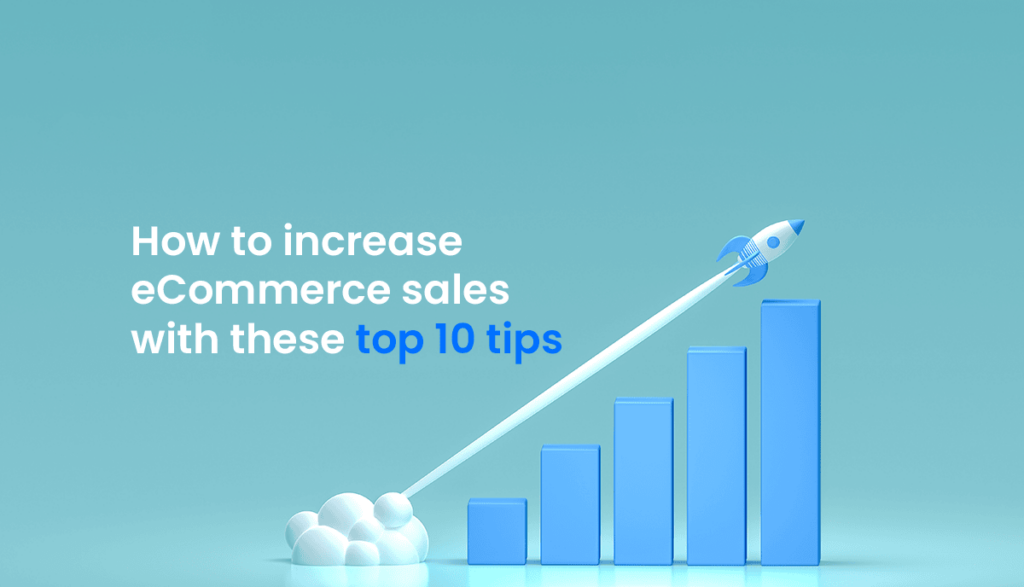Build it, and they will come…when did that ever happen? You may have a great product and an amazing site, but that doesn’t guarantee sales. First, you have to create awareness, drive traffic to your site, engage shoppers and deliver a great customer experience that will encourage them to complete a purchase. Then, you have to ensure that the post-purchase experience is also great to foster loyalty. Easier said than done. You’ll need strategies and tactics to boost sales, increase orders and retention.
In this post, we will share ten proven tactics for increasing eCommerce sales and online revenue.
What are the factors affecting online sales?
Online sales are typically affected by a mix of external and internal factors. Factors that are out of our control, like market trends and competitor activities, can have a huge impact on sales numbers. Depending on your business and the products you sell, seasonal buying patterns will also lead to sales fluctuations.
Essentially, eCommerce sales are driven by three main factors: how many shoppers visit your site, the percentage of visitors that buy and how much money they spend.
Typically, driving more eCommerce traffic to your site will increase the number of potential customers, likely resulting in increased eCommerce sales. But driving more traffic is only part of the battle. The conversion rate — the percentage of visitors to your eCommerce site that complete a transaction—is equally important. By boosting your conversion rate, you’ll ultimately increase eCommerce sales.
Finally, customer lifetime value (CLV) will influence your eCommerce success. CLV refers to the total amount of money a customer is expected to spend with your company over the course of your relationship. The average value depends on the purchase frequency, the average order value and the customer retention rate. By increasing the retention rate or the average value of each purchase, you’ll be able to increase the customer value and thus increase eCommerce sales.
10 strategies to increase eCommerce sales
Before developing your eCommerce sales growth strategy, you’ll need to understand your current sales pattern, including key eCommerce metrics such as your traffic, traffic sources, conversion rates and so on. Understanding these metrics will help you get a complete picture of the strengths and weaknesses of your business and determine what strategies will yield the greatest return on your investment for all stages of the sales funnel.
Ultimately, boosting eCommerce sales requires a mix of strategies to attract customers, engage them effectively and encourage them to complete a transaction. The best approach for increasing eCommerce sales depends on your business, budget, resources and market. Here are 10 proven strategies to consider:
- Optimise the customer experience. Driving traffic to your website is only part of the battle. Delivering the best customer experience possible to ensure that hard-earned site traffic converts to sales is critical. This is why it is important to ensure that your website is user-friendly, easy to navigate, engaging and mobile-optimised. A great site experience should be fast and seamless, and the checkout process should be smooth and frictionless. You should continuously evaluate and optimise your site, paying attention to the entire purchase journey and all customer touchpoints.
- Develop a content marketing strategy. Developing and featuring relevant content on an eCommerce site can help drive more online sales and build customer loyalty. Great content can be used across customer touchpoints, including your website, mobile app, email marketing, and social media, and it can be both educational, informative, and promotional. Content can take many forms and include blog posts, how-to guides, images and videos. Some retailers and brands augment their content strategies with user-generated content (UGC), adding authenticity and building trust, and serving as a type of social proof that encourages sales.
- Launch a loyalty program. As a general rule of thumb, selling to an existing customer base is six to seven times cheaper than acquiring new customers. Building loyalty and encouraging repeat sales from your existing customers will pay off. A popular way to recognise and reward existing customers is through a loyalty program. Loyalty programs offer a structured way to incentivise customers for purchases and other behaviours including referrals or even social media mentions. Designed to improve retention rates, encourage repeat purchases and increase order values, a well-designed loyalty program presents a great opportunity to grow sales and build strong customer relationships.
- Highlight cross-sell and upsell opportunities. Retailers and brands leverage upsell and cross-sell strategies to increase online sales by encouraging shoppers to buy related and complementary products (cross-sell) or getting them to buy a more expensive version of a given product (upsell). This is often done by leveraging product recommendations. Use personalised product recommendations based on shoppers’ browsing and purchase history to showcase relevant products and encourage shoppers to buy more, and use social proof recommendations to also layer in the behaviours of other shoppers. Depending on your business, outfitting, bundling, and threshold messaging are also great ways to encourage shoppers to add more to cart and increase AOV.
- Leverage social proof messaging. By displaying trends and behaviours of other shoppers throughout the shopping journey, retailers and brands can help shoppers make more informed shopping decisions, giving them the confidence to buy. Powered by real-time data and the wisdom of the crowd, social proof messaging allows you to highlight best-selling and trending products, key product attributes, inventory details and much more.
- Invest in paid advertising. Paid ad campaigns can be a powerful tool to create awareness, drive traffic and increase sales. Paid ad campaigns can take different forms, including traditional print advertising and digital advertising. Many retailers and brands prefer digital ad campaigns like social media displays and search engine ads because they are often more productive and cost-effective. Digital ad platforms allow you to target very specific demographics, interests, and behaviours to ensure that ads are being seen by the right audiences. These platforms also provide detailed analytics that allow them to track the performance and make data-driven decisions to optimise campaigns for better results.
- Focus on SEO. Most shoppers start their purchase journey on a search engine, and it is therefore not surprising that search engine optimisation (SEO) is a high priority for retailers and brands. By using various SEO techniques, you can improve your site’s rankings and visibility in search results and high-quality and relevant content can help drive organic traffic to your site. Relevant search terms (keywords) in your product descriptions, image alt text, page URLs, headings, and optimised page speed should all be part of your SEO strategy.
- Partner with influencers. Partnering with influencers can help you build awareness, establish credibility and ultimately increase eCommerce sales. Whether partnering with influencers through informal, unpaid initiatives or more formal long-term partnerships, the key is to target influencers whose audience aligns with your target customers and incentivise them to create authentic and compelling content as well as discounts to share with their followers. By building strong relationships with influencers and co-creating content that resonates with their audience, you can tap into new markets, increase brand awareness, and ultimately drive eCommerce sales.
- Leverage social media. Use social media platforms to engage with your audience, increase awareness, promote products and drive traffic to your eCommerce site by encouraging your followers to click through to your site. Engaging with your customers on social media is also a great way to share product updates and educational content. It offers a way for your customers and prospective customers to learn more about you and your business, as well as for you to learn more about them and foster relationships that help improve retention and encourage repeat purchases. You will want to leverage the social media platforms where your customers are most active, and it is recommended that you use a social media management tool to help create and manage content as well as track performance. You can also invest in paid advertising or boost posts on social media platforms to broaden your reach.
- Don’t forget about email marketing. Traditional email marketing remains a very popular and effective marketing tactic. Email lets you easily communicate with customers and build and maintain relationships. By sending targeted campaigns, personalised content and promotions, you can drive traffic to your site and encourage repeat purchases. The more customers and prospective customers that join your list, the broader your reach, and for this reason, many retailers and brands offer incentives for shoppers and customers to join their mailing lists via newsletters etc.
Uplift your eCommerce orders
Overall, eCommerce sales continue to grow, but competition is heating up, making it harder for retailers and brands to increase online sales. Customers are more digitally savvy and demanding, and as a result, you need to constantly refine eCommerce strategies to increase sales.
Implementing a mix of the proven strategies outlined above can help you attract more customers, increase sales, and grow your eCommerce business.
From fashion to beauty and home improvement, Taggstar’s social proof messaging platform has proven to significantly increase conversions and sales for leading retailers and brands. Try our conversion rate calculator to see how social proof messaging can improve the customer experience and conversion rate for your eCommerce business.



